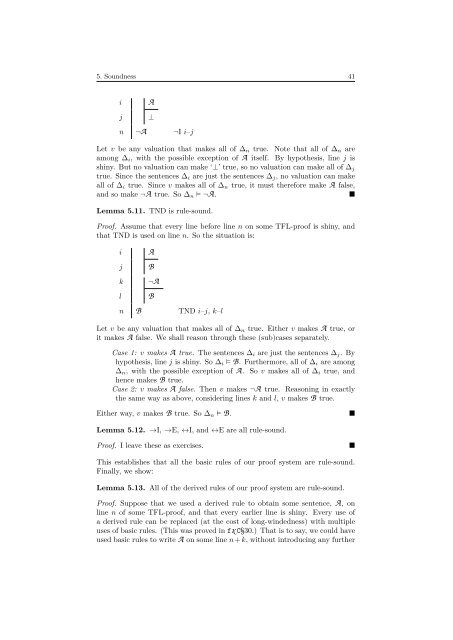Metatheory - University of Cambridge
Metatheory - University of Cambridge
Metatheory - University of Cambridge
Create successful ePaper yourself
Turn your PDF publications into a flip-book with our unique Google optimized e-Paper software.
5. Soundness 41<br />
i<br />
j<br />
A<br />
⊥<br />
n ¬A ¬I i–j<br />
Let v be any valuation that makes all <strong>of</strong> ∆ n true. Note that all <strong>of</strong> ∆ n are<br />
among ∆ i , with the possible exception <strong>of</strong> A itself. By hypothesis, line j is<br />
shiny. But no valuation can make ‘⊥’ true, so no valuation can make all <strong>of</strong> ∆ j<br />
true. Since the sentences ∆ i are just the sentences ∆ j , no valuation can make<br />
all <strong>of</strong> ∆ i true. Since v makes all <strong>of</strong> ∆ n true, it must therefore make A false,<br />
and so make ¬A true. So ∆ n ⊨ ¬A.<br />
■<br />
Lemma 5.11. TND is rule-sound.<br />
Pro<strong>of</strong>. Assume that every line before line n on some TFL-pro<strong>of</strong> is shiny, and<br />
that TND is used on line n. So the situation is:<br />
i<br />
j<br />
A<br />
B<br />
k ¬A<br />
l<br />
B<br />
n B TND i–j, k–l<br />
Let v be any valuation that makes all <strong>of</strong> ∆ n true. Either v makes A true, or<br />
it makes A false. We shall reason through these (sub)cases separately.<br />
Case 1: v makes A true. The sentences ∆ i are just the sentences ∆ j . By<br />
hypothesis, line j is shiny. So ∆ i ⊨ B. Furthermore, all <strong>of</strong> ∆ i are among<br />
∆ n , with the possible exception <strong>of</strong> A. So v makes all <strong>of</strong> ∆ i true, and<br />
hence makes B true.<br />
Case 2: v makes A false. Then v makes ¬A true. Reasoning in exactly<br />
the same way as above, considering lines k and l, v makes B true.<br />
Either way, v makes B true. So ∆ n ⊨ B.<br />
■<br />
Lemma 5.12. →I, →E, ↔I, and ↔E are all rule-sound.<br />
Pro<strong>of</strong>. I leave these as exercises.<br />
■<br />
This establishes that all the basic rules <strong>of</strong> our pro<strong>of</strong> system are rule-sound.<br />
Finally, we show:<br />
Lemma 5.13. All <strong>of</strong> the derived rules <strong>of</strong> our pro<strong>of</strong> system are rule-sound.<br />
Pro<strong>of</strong>. Suppose that we used a derived rule to obtain some sentence, A, on<br />
line n <strong>of</strong> some TFL-pro<strong>of</strong>, and that every earlier line is shiny. Every use <strong>of</strong><br />
a derived rule can be replaced (at the cost <strong>of</strong> long-windedness) with multiple<br />
uses <strong>of</strong> basic rules. (This was proved in fx C§30.) That is to say, we could have<br />
used basic rules to write A on some line n + k, without introducing any further
















